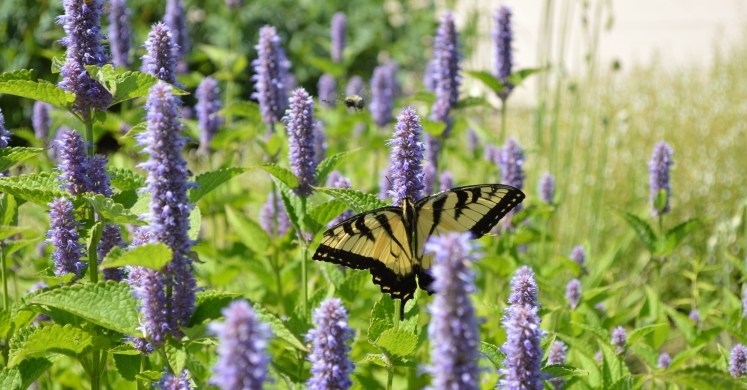Blog

#bioPGH Blog: Blue Giant Hyssop
 A resource of Biophilia: Pittsburgh, #bioPGH is a weekly blog and social media series that aims to encourage both children and adults to reconnect with nature and enjoy what each of our distinctive seasons has to offer. From the best times to plant seasonal flora and enjoy their peak blooms, to astronomical events and creatures to keep an eye and ear out for, Phipps will keep you in the know with what’s going on in our environment!
A resource of Biophilia: Pittsburgh, #bioPGH is a weekly blog and social media series that aims to encourage both children and adults to reconnect with nature and enjoy what each of our distinctive seasons has to offer. From the best times to plant seasonal flora and enjoy their peak blooms, to astronomical events and creatures to keep an eye and ear out for, Phipps will keep you in the know with what’s going on in our environment!
Blue giant hyssop, anise hyssop, lavender hyssop: a plant known by many names — and even more pollinators. An herbivore- and drought-tolerant plant that grows well in wet areas and feeds a wide variety of insects, hyssop (Agastache foeniculum) is a great addition to a backyard garden. This herbaceous perennial in the mint family (Lamiaceae) is native to North America but related to other hyssop species in the Mediterranean and central Asia. Hyssop grows from 2 – 3.5 feet tall and produces showy, delicate purple flowers that are packed together into cylindrical, fuzzy spikes. You can find it at the Center for Sustainable Landscapes in both our Green Roof and our rain garden.
Here at Phipps, you will find hyssop abuzz with insects; it is an important nectar and pollen source for both European honeybees and native bumblebees. Hyssop also attracts non-Apis species such as hoverflies, butterflies and moths. However, some Lepidoptera (the insect order of moths and butterflies) are common garden and agricultural pests. In agricultural settings, hyssop therefore presents a tradeoff: it attracts both crucial pollinators and agricultural pests that eat or damage crops. So what’s a farmer to do? Fortunately, there is a fascinating third layer of complexity — parasitoids! These insects belong mainly to the Hymenoptera order (bees, ants, wasps and kin), and while they are free-living as adults, they lay eggs on or in other insects. The larval parasitoid then develops within or on its host, slowly consuming and eventually killing it. This might make you say “ewww,” but it’s true, and scientists have taken advantage of these natural enemies as a form of biological pest control. Though they may seem unusual, parasitoids are thought to account for about 10% of the world’s species. A recent survey of native plants grown among agricultural crops found that hyssop attracted high numbers of both pests and parasitoids, so it may not be the best planting choice for agricultural pest management. (An ideal plant for biological pest control would attract more parasitoid than pest species, thus reducing insecticide usage.)
Beyond supporting a wide variety of insects, hyssop’s chemical properties have long benefitted humans. Hyssop has been used to treat medical conditions: Native Americans used the plant as a remedy for cough, fever and heart conditions, and externally for treating burns. Recent research found that distillation of compounds in the hyssop plant provided an effective natural control against grain pests like the red flower beetle (Tribolium castaneum) and the lesser grain borer (Rhyzopertha dominica). These essential oils, which contain the "essence" of a plant, or the concentrated chemical aroma compounds, act as environmentally-friendly alternatives to synthetic insecticides because they are biodegradable and have low toxicity in mammals.
Connecting to the Outdoors Tip: We encourage you to learn more about native plants like hyssop in Phipps’ adult education classes. In these classes you can learn what native plants are appropriate for a fall garden, or improve your botanical field sketching. For families looking for outdoor activities, there are a number of nature walks happening in western PA in the coming weeks. Take a nature walk in Ohiopyle or stay local and explore nature in Schenley Park.
Continue the Conversation: Share your nature discoveries with our community by posting to Twitter and Instagram with hashtag #bioPGH, and R.S.V.P. to attend our next Biophilia: Pittsburgh meeting.
Resources:
Center for Sustainable Landscapes | Phipps Conservatory and Botanical Gardens
Wild Pollinators of Eastern Apple Orchards | Cornell University
Conserving Bumble Bees | Greatsunflower.org
Quantifying variation among garden plants in attractiveness | Functional Ecology
Adult Education Classes | Phipps Conservatory and Botanical Gardens
Ohiopyle Nature Walk | Pennsylvania DCNR
Schenley Park Nature Walk | Learnyourland.com

